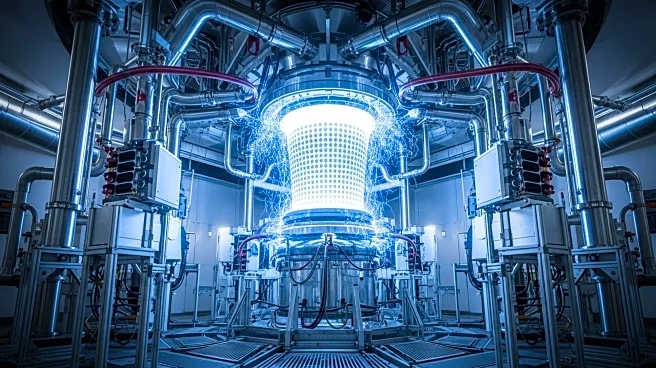What is the story about?
What's Happening?
Researchers at a government lab have developed an exhaust system that significantly reduces the extreme heat within fusion reactors, a major challenge in nuclear fusion technology. The study, published in Nature Energy, explores Alternative Divertor Configurations (ADCs) to protect reactor walls from intense plasma heat. The 'Super-X divertor' design extends plasma 'legs,' allowing more space for cooling before reaching the divertor walls. This innovation demonstrates substantial benefits in controlling fusion heat, marking a pivotal advancement in making nuclear fusion more practical and cost-effective. The collaborative effort involved multiple research institutions, highlighting the potential for nuclear fusion to provide clean, limitless energy without the radioactive waste associated with nuclear fission.
Why It's Important?
The breakthrough in managing fusion reactor heat is a significant step towards harnessing nuclear fusion as a viable energy source. Fusion offers a cleaner alternative to fossil fuels, as it does not produce carbon dioxide or long-lasting radioactive waste. This development could accelerate the transition to renewable energy, reducing reliance on fossil fuels and contributing to global efforts to combat climate change. The ability to control plasma conditions independently enhances the feasibility of future fusion machines, potentially revolutionizing energy production and supporting sustainable development goals. As fusion technology advances, it may play a crucial role in achieving energy security and reducing environmental impact.
What's Next?
Continued research into nuclear fusion will focus on refining the exhaust system and exploring additional safety measures. The promising results may attract further investment and collaboration among international research institutions. Governments and energy companies will likely consider fusion as part of their long-term energy strategies, potentially leading to increased funding and policy support. The development of robust control systems for plasma exhaust will be essential for the commercialization of fusion technology. Stakeholders will need to address technical challenges and regulatory requirements to facilitate widespread adoption.
Beyond the Headlines
The advancement in fusion technology raises questions about the future of energy production and its impact on society. While fusion offers environmental benefits, the transition to this new energy source will require significant infrastructure changes and investment. Ethical considerations include ensuring equitable access to fusion energy and addressing potential disruptions to existing energy markets. The collaboration among research institutions underscores the importance of international cooperation in tackling global challenges. Long-term, fusion could redefine energy paradigms and contribute to a more sustainable and resilient future.
AI Generated Content
Do you find this article useful?














